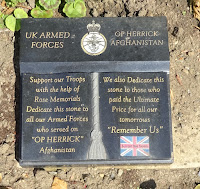 |
| National Memorial Arboretum 49th (West Riding) Division Memorial |
The 49th (West Riding) Division was a Territorial Army formation which mobilised at the beginning of World War Two.
It undertook home defence duties before two of it's three Brigades were sent to Norway. The operation in Norway failed, and the two brigades returned to the UK in May 1940. The Division was re-constituted with 146 Brigade and 147 Brigade, and sent to Iceland in May / June 1940. It was joined in October 1940 by 70 Brigade which consisted of the 10th and 11th Battalions Durham Light Infantry, plus 1st Battalion Tyneside Scottish (Black Watch).
 |
| 49th Division Iceland |
 |
| 49 Division Iceland Tyneside Scottish Pipe Band |
The 49th Division adopted a Polar Bear standing on an ice flow as the divisional insignia.
 |
| 49(West Riding) Division Polar Bear |
At the end of 1941 Divisional units began handing over the responsibility for the defence of Iceland to the US Marines, By April 1942, all units had returned to the UK. The 49th was reconstituted in South Wales and began to prepare for the invasion of Europe.
The appointment of a new GOC in May 1943 saw the adoption of a more aggressive Polar Bear as the divisional insignia.
.jpeg) |
| 49 (West Riding) Division Polar Bear |
On 6th June 1944 Allied Forces landed in Normandy, the start of the liberation of Europe. The 49th Division was a follow on Division which began arriving on Gold Beach on 12th June 1944. They would undertake operations as part of the capture of Caen and breakout from the Normandy Bridgehead.
 |
| 49 (West Riding) Division Normandy 1944 |
The Divisions first major operation was OPERTION MARTLET. The 49th were tasked with the capture of the Rauray Spur in order to protect the right flank of OPERATION EPSOM which was intended to seize Caen.
 |
Operation Martlet began on 25th June. The 1st Battalion Tyneside Scottish were initially in reserve. Once committed to the battle they fought actions around Tessel Wood and Brettevillette before digging in south of the village of Rauray to prepare for a German Counter attack.
On 1st July 1944 the 49th Division successfully blocked German SS Panzer troops from breaking through the British line. The 1st Battalion Tyneside Scottish would win the battle honour ' Defence of Rauray'.
The 49th Division Memorial at the National Memorial Arboretum features a Polar Bear, the divisional insignia.
 |
| 49th (West Riding) Division Memorial Polar Bear |
The memorial records the battle areas where it the division fought. This includes Tessel Wood and Rauray where the 1st Battalion Tyneside Scottish were engaged.
 |
| 49th (West Riding) Division Memorial Battle Areas - Tessel Wood and Rauray |
 |
| 49th (West Riding) Division Memorial 70th and 56th Brigade |
 |
| 49th (West Riding) Division Memorial 1st Battalion Tyneside Scottish (Black Watch) |
As a result of the losses in Normandy the 1st Battalion Tyneside Scottish (Black Watch) was placed in suspended animation and it's personnel posted to other battalions of the Black Watch. The 70th Brigade was disbanded in October 1944 and replaced by the 56th Brigade. The Division advanced through North West Europe, their last major engagement was in April 1945 in the battles to liberate Arnhem.






































































